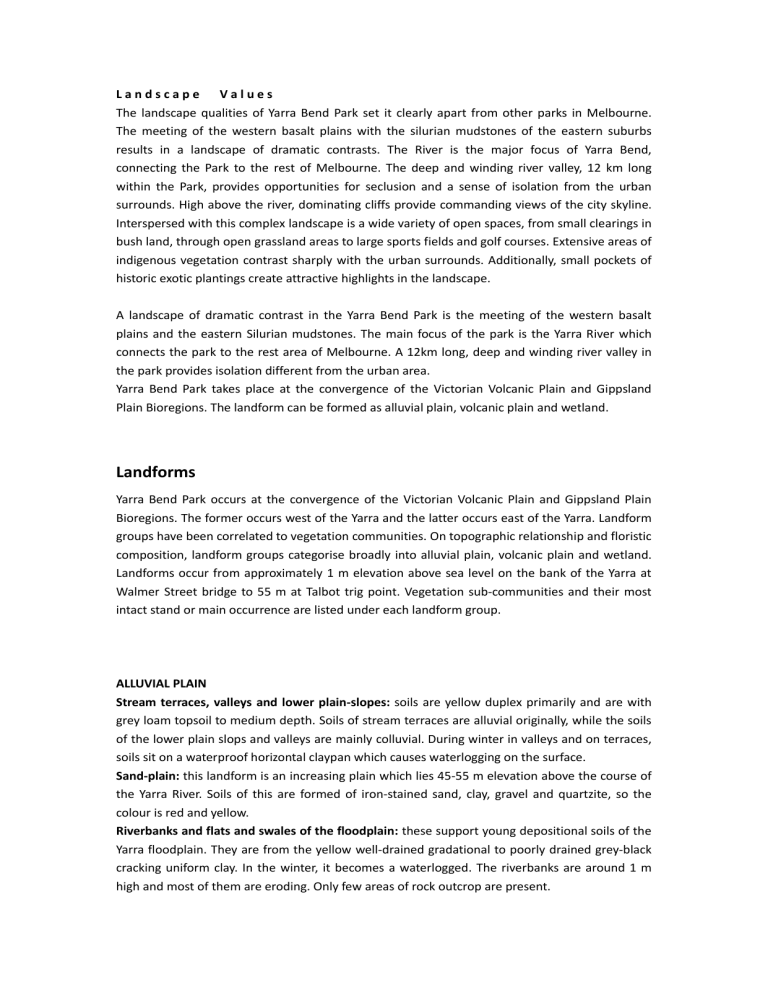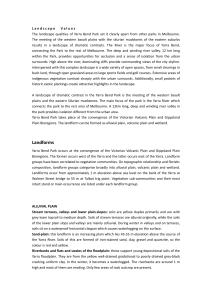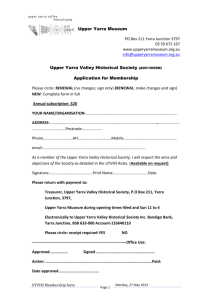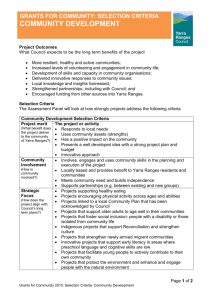
Landscape Values The landscape qualities of Yarra Bend Park set it clearly apart from other parks in Melbourne. The meeting of the western basalt plains with the silurian mudstones of the eastern suburbs results in a landscape of dramatic contrasts. The River is the major focus of Yarra Bend, connecting the Park to the rest of Melbourne. The deep and winding river valley, 12 km long within the Park, provides opportunities for seclusion and a sense of isolation from the urban surrounds. High above the river, dominating cliffs provide commanding views of the city skyline. Interspersed with this complex landscape is a wide variety of open spaces, from small clearings in bush land, through open grassland areas to large sports fields and golf courses. Extensive areas of indigenous vegetation contrast sharply with the urban surrounds. Additionally, small pockets of historic exotic plantings create attractive highlights in the landscape. A landscape of dramatic contrast in the Yarra Bend Park is the meeting of the western basalt plains and the eastern Silurian mudstones. The main focus of the park is the Yarra River which connects the park to the rest area of Melbourne. A 12km long, deep and winding river valley in the park provides isolation different from the urban area. Yarra Bend Park takes place at the convergence of the Victorian Volcanic Plain and Gippsland Plain Bioregions. The landform can be formed as alluvial plain, volcanic plain and wetland. Landforms Yarra Bend Park occurs at the convergence of the Victorian Volcanic Plain and Gippsland Plain Bioregions. The former occurs west of the Yarra and the latter occurs east of the Yarra. Landform groups have been correlated to vegetation communities. On topographic relationship and floristic composition, landform groups categorise broadly into alluvial plain, volcanic plain and wetland. Landforms occur from approximately 1 m elevation above sea level on the bank of the Yarra at Walmer Street bridge to 55 m at Talbot trig point. Vegetation sub-communities and their most intact stand or main occurrence are listed under each landform group. ALLUVIAL PLAIN Stream terraces, valleys and lower plain-slopes: soils are yellow duplex primarily and are with grey loam topsoil to medium depth. Soils of stream terraces are alluvial originally, while the soils of the lower plain slops and valleys are mainly colluvial. During winter in valleys and on terraces, soils sit on a waterproof horizontal claypan which causes waterlogging on the surface. Sand-plain: this landform is an increasing plain which lies 45-55 m elevation above the course of the Yarra River. Soils of this are formed of iron-stained sand, clay, gravel and quartzite, so the colour is red and yellow. Riverbanks and flats and swales of the floodplain: these support young depositional soils of the Yarra floodplain. They are from the yellow well-drained gradational to poorly drained grey-black cracking uniform clay. In the winter, it becomes a waterlogged. The riverbanks are around 1 m high and most of them are eroding. Only few areas of rock outcrop are present. Escarpments and gullies, cliffs and spurs: these occur within 300 m of the river and are the sedimentary landform. As the Yarra River intersects a spur, it develops a meander, so that the steep cliffs are occurred. Gentler escarpments (bluffs) occupy on the inner side near the river and the escarpment gullies occurs along the east side of the Yarra River. The soils of the cliffs are derived from the old alluvium and the recent erosion. VOLCANIC PLAIN Quaternary volcanic silt plain: this landform occupies the Western Volcanic Plain at the north of Merri Creek. In the wet years, it is poor to drain with the topsoil and becomes the waterlogged. Soils are originated from the volcanic and sedimentary sources, and soils in swales are contained of black cracking clay. Creek: the Merri Creek is a slow flowing which next to the Yarra River. It consists of limited floodplain terraces and small gorges with basalt reefs and columnar basalt cliffs. Escarpments and cliffs: these are volcanic landforms which exist within 50 m of Merri Creek and Yarra River. The cliffs support columnar basalt outcrop and the soils are red and gradational. WETLAND Freshwater meadows: freshwater meadows are the wetlands that inundate less than 6 months and the depth is less than 0.3 m when it is full. The flood plain swales and surface diggings support semi-aquatic vegetation and soils on the floodplain are a mixture of sand, gravel and organic alluviums. Freshwater marshes: freshwater marshes are defined as wetland which inundated 6 to 9 months of the year or has an average depth of less than 1 m when full. Soils of the freshwater marshes are predominantly uniform organic clays and the colour is grey-black.



